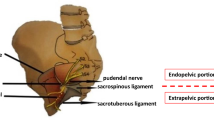Abstract
Purpose
Pudendal nerve injection is used as a diagnostic procedure in the vulvar region and for therapeutic purposes, such as in vulvodynia. Here, we provide a new, easy-to-perform perineal injection technique.
Patients and methods
We analyzed 105 perineal injections into the pudendal nerve with a local anesthetic (LA), procaine in 20 patients. A 0.4 × 40 mm needle was handled using a stop-and-go technique while monitoring the patient’s discomfort. The needle was placed 1–2 cm laterally to the dorsal introitus. After aspiration, a small amount of LA was applied. After subcutaneous anesthesia, the needle was further advanced step-by-step. Thus, 5 ml could be applied with little discomfort to the patient. Anesthesia in the pudendal target region was the primary endpoint of our analysis.
Results
In 93 of 105 injections (88.6 %), complete perineal anesthesia was achieved with a single injection. 12 injections were repeated. These injections were excluded from the analysis. Severity of injection pain, on visual analog scale (VAS) from 0 to 100, was 26.8 (95 % CI 7.2–46.4). Age (β = 0.33, p < 0.01) and the number of previous injections (β = 0.35, p < 0.01) inversely correlated with injection pain. Injection pain and anesthesia were not affected by BMI, the number and the side of previous injections, or order of injection. A reversible vasovagal reaction was common, but no serious adverse effects occurred.
Conclusion
Perineal pudendal injection is an effective and safe technique for anesthesia in diagnostic (vulva biopsy) and therapeutic indications (pudendal neuralgia), and regional anesthesia in perinatal settings.





Similar content being viewed by others
References
Reed BD et al (2012) Prevalence and demographic characteristics of vulvodynia in a population-based sample. Am J Obstet Gynecol 206:170.e1–170.e9
Bellingham GA et al (2012) Randomized controlled trial comparing pudendal nerve block under ultrasound and fluoroscopic guidance. Reg Anesth Pain Med 37(3):262–266
Sibert L et al (2010) Epididymal and testicular chronic pain. Prog Urol 20(12):962–966
Schraffordt SE et al (2004) Anatomy of the pudendal nerve and its terminal branches: a cadaver study. ANZ J Surg 74(1–2):23–26
Hough DM et al (2003) Chronic perineal pain caused by pudendal nerve entrapment: anatomy and CT-guided perineural injection technique. AJR Am J Roentgenol 181(2):561–567
Rofaeel A et al (2008) Feasibility of real-time ultrasound for pudendal nerve block in patients with chronic perineal pain. Reg Anesth Pain Med 33(2):139–145
Gruber H et al (2001) New, simple, ultrasound-guided infiltration of the pudendal nerve: topographic basics. Dis Colon Rectum 44(9):1376–1380
Robert R et al (1998) Anatomic basis of chronic perineal pain: role of the pudendal nerve. Surg Radiol Anat 20(2):93–98
Narouze S, Peng PW (2010) Ultrasound-guided interventional procedures in pain medicine: a review of anatomy, sonoanatomy, and procedures. Part II: axial structures. Reg Anesth Pain Med 35(4):386–396
Kim SH et al (2012) Nerve-stimulator-guided pudendal nerve block by pararectal approach. Colorectal Dis 14(5):611–615
Ford JM et al (2013) A critique of current practice of transvaginal pudendal nerve blocks: a prospective audit of understanding and clinical practice. J Obstet Gynaecol 33(5):463–465
Prat-Pradal D et al (2009) Anatomical basis of transgluteal pudendal nerve block. Surg Radiol Anat 31(4):289–293
Peng PW, Tumber PS (2008) Ultrasound-guided interventional procedures for patients with chronic pelvic pain—a description of techniques and review of literature. Pain Physician 11(2):215–224
Weinschenk S et al (2013) Successful therapy of vulvodynia with local anaesthetics. A case report. Forsch Komplementmed 20(2):138–143
Hamilton JG (1995) Needle phobia: a neglected diagnosis. J Fam Pract 41(2):169–175
Hogan ME, Kikuta A, Taddio A (2010) A systematic review of measures for reducing injection pain during adult immunization. Vaccine 28(6):1514–1521
Andrews JC (2011) Vulvodynia interventions—systematic review and evidence grading. Obstet Gynecol Surv 66(5):299–315
Bossuyt PM et al (2003) Towards complete and accurate reporting of studies of diagnostic accuracy: the STARD initiative. BMJ 326(7379):41–44
Amarenco G et al (1997) Treatments of perineal neuralgia caused by involvement of the pudendal nerve. Rev Neurol (Paris) 153(5):331–334
Rigaud J et al (2010) Somatic nerve block in the management of chronic pelvic and perineal pain. Prog Urol 20(12):1072–1083
Amarenco G et al (1988) Alcock’s canal syndrome and perineal neuralgia. Rev Neurol (Paris) 144(8–9):523–526
Kovacs P et al (2001) New, simple, ultrasound-guided infiltration of the pudendal nerve: ultrasonographic technique. Dis Colon Rectum 44(9):1381–1385
Hollmann MW, Durieux ME (2000) Prolonged actions of short-acting drugs: local anesthetics and chronic pain. Reg Anesth Pain Med 25(4):337–339
Hollmann MW, Herroeder S (2010) Studies concerning “alternative” clinical effects of local anaesthetics. In: Weinschenk S (ed) Handbuch Neuraltherapie. Elsevier, München, pp 1058–1062
Cassuto J, Sinclair R, Bonderovic M (2006) Anti-inflammatory properties of local anesthetics and their present and potential clinical implications. Acta Anaesthesiol Scand 50(3):265–282
Perlas A (2010) Evidence for the use of ultrasound in neuraxial blocks. Reg Anesth Pain Med 35(2 Suppl):S43–S46
Kass JS et al (2010) Sectional neuroanatomy of the pelvic floor. J Comput Assist Tomogr 34(3):473–477
Activities of the Heidelberg Neural Therapy Education and Research (HUNTER) Group 2015; Available http://www.hunter-heidelberg.com. Accessed 21 May 2015
Weinschenk S (2012) Neural therapy—a review of the therapeutic use of local anaesthetics. Acupunct Rel Ther 4(1):25–29
Acknowledgments
The authors wish to thank Richard Göllner, University of Tubingen, for helpful advice on the statistical evaluation, Pia Hofheinz, M.Sc., Karlsruhe, for her help in data management, and Ewa Gubb and Helga Gutz, Karlsruhe, for her assistance in the English translation.
Author information
Authors and Affiliations
Corresponding author
Ethics declarations
Conflict of interest
This study was neither sponsored nor funded. The authors declare no conflict of interest.
Rights and permissions
About this article
Cite this article
Weinschenk, S., Hollmann, M.W. & Strowitzki, T. New perineal injection technique for pudendal nerve infiltration in diagnostic and therapeutic procedures. Arch Gynecol Obstet 293, 805–813 (2016). https://doi.org/10.1007/s00404-015-3812-0
Received:
Accepted:
Published:
Issue Date:
DOI: https://doi.org/10.1007/s00404-015-3812-0




